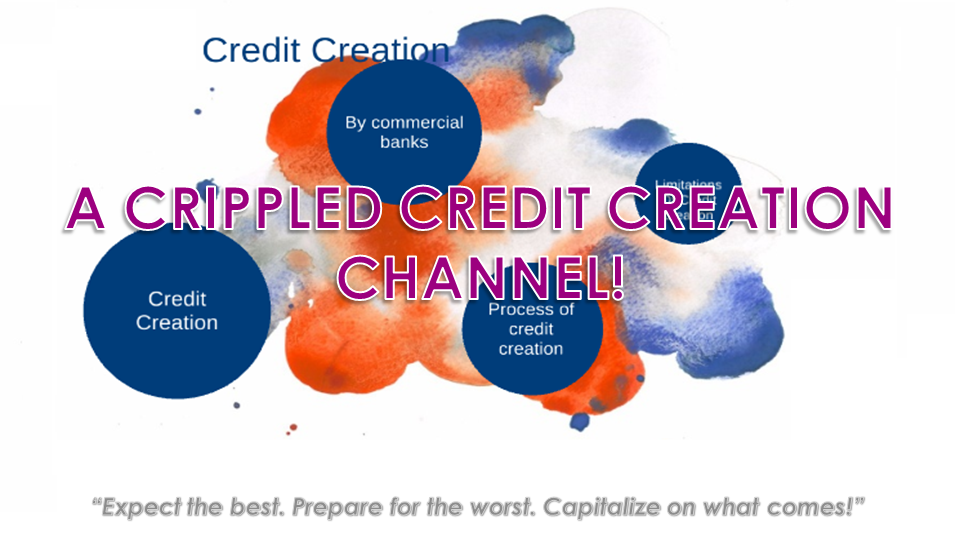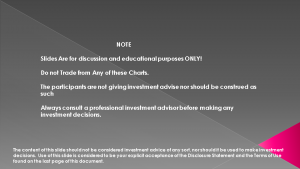IN-DEPTH: TRANSCRIPTION - UnderTheLens - 04-26-23 - MAY - A Crippled Credit Creation Channel
SLIDE DECK
TRANSCRIPTION
SLIDE 2
Thank you for joining me. I'm Gord Long.
A REMINDER BEFORE WE BEGIN: DO NO NOT TRADE FROM ANY OF THESE SLIDES - they are COMMENTARY for educational and discussions purposes ONLY.
Always consult a professional financial advisor before making any investment decisions.
SLIDE 3 - COVER
Credit and the Credit markets are going to continue to dominate the concerns of the financial markets for 2023 and 2024. Easy credit is now in the rear view mirror, few yet fully understand this!
Why?
We have had over 40 years of ever loosening credit standards and expansionary monetary policy. This is a dangerous cocktail mix that has resulted in the explosion of the “Financialization” of the global economy.
… as I said that era is now behind us and the sooner you come to grips with this reality, the better suited you will be to both recognize and take advantage of the new regime.
SLIDE 4 – AGENDA
In this session I want to talk about a number of the pillars and channels that have supported easy credit so that we better recognize where the “tectonic” plates have shifted and where the cracks have developed.
I have written a lot about Credit, so for our long time readers I will try and focus primarily on what is central to our current recognition.
As such I want to cover the items shown here.
SLIDE 5
I have always maintained and continue to believe that “Credit Leads the Way”! Credit consistently shows us what is ahead - before other markets have begun reacting.
It signals where the problems are and what to watch.
SLIDE 6
I have often used this “DOG” metaphor to add clarity.
A dog smells problems often before its other senses fully identify them.
The Credit Market leads the Currency markets and Bond markets which then react in a synchronized fashion, but with global diffusion and delay taking time.
The equity markets lag and like a dog the tail may still be wagging as it determines the severity of the problem. When it does the hair on its back stands up as it then stops wagging its tail. Watching the dog’s tail is a lagging indicator – not a leading indicator.
SLIDE 7
Presently we have credits problems showing in a multitude of areas that we will touch on in this session.
The point to recognize is that some are now beginning to show in Currency and Bonds Markets and with varying impacts globally.
The Equity markets are complacent to the storm and the equity tail is still wagging as though it will soon be fed – more of what is has become accustomed too.
SLIDE 8
That is not going to occur because the primary credit pillars that have fed the financial and equity markets for 40 years are no longer functioning.
SLIDE 9
Let’s start with where the credit for debt comes from to fund the biggest consumption economy in the world – the US. The US has long consumed more than it produces which the credit markets have been willing to fund because the underlying collateral was solid. The US through to the 1980’s was the wealthiest country in the world and rested upon a massive amount of untapped collateral wealth for debt creation.
As this chart shows by the blue area, before the US came off the gold standard because it chose not to finance President Johnson’s Great Society nor the Vietnam War through taxation of the national savings, it resorted to Credit Creation (in black). The US began taking on debt instead of paying its bills from earnings.
Capitalism is about Savings being invested into Productive Assets which increases the standard of living. We began slowly to move towards Creditism where instead of savings we use Debt or Credit to invest in consumption versus productive assets. This was a big part of the US moving towards becoming an 80% consumption economy.
That has worked until recently!
This chart illustrates that the US now has multiple problems with funding itself. All of these are centered on the Rate of Change of each of its funding channels:
- Saving at the bottom (in blue) has become almost meaningless and continues to weaken,
- The Rest of the World (in red) has started reducing its investment in the US. Russia sold all its US Treasuries in 2018, while China and Japan has reduced their rate of accumulating US Reserves. Many countries have shifted away from US Treasury holdings for various reasons including the “Weaponization” of the US dollar through sanctions to enforce US foreign policy.
- The Fed (in Green) has also stopped Quantitative Easing which bought US Treasury debt products. It is now executing a program of Quantitative Tightening to reduce the Fed’s nearly $9T balance sheet.
- The US Domestic Credit Creation engine appears to have stalled (in black) and is not taking up the required slack being created by the other areas.
Let’s start with understanding #4 and the US Credit Creation Engine.
SLIDE 10
To repeat from the previous slide it isn’t that credit and US debt funding is being reduced but rather the RATE OF INCREASE is slowing. That rate doesn’t support the need required to maintain US economic growth which is completely addicted to credit funded growth.
Like a farmer you can’t sell your entire crop. A certain percentage must be held as seed for the next crop or money must be found to buy seed. The US has long stopped keeping seed needs and requires financing to plant an ever expanding farm size.
When the price of the seed goes up, problems get serious – but I am getting ahead of myself – I digress.
As this chart shows the US has done an extraordinary job of creating credit since August of 1971 when it came off the gold standard where its debt had to be paid, versus financed through credit.
When Total Credit contracted by half a trillion dollars in 2009, the US economy came close to collapsing into a new Great Depression. That was averted because of a huge expansion in Government Debt caused total credit to expand again.
SLIDE 11
This is shown by the green area of Fed credit creation quickly expanding from 2008 on to take up the slack of the inability of the US domestic credit creation (in black) to deliver at an increasing rate.
SLIDE 12
When you consider total credit to GDP you quickly see that credit has increased much more rapidly than the economy has grown, particularly between 1980 and 2009.
Since 2009 it is flat and has recently turned down.
SLIDE 13
When we look at actual annual dollar change in total credit (versus rate of change) we see the last year total credit grew by $5.1T or 37% less than during 2020 – the year that government debt spiked at the start of the pandemic.
SLIDE 14
Where has the need for Debt been coming from remembering that Credit must equal Debt when it is financed? In the 15 years since 2007 government debt jumps off the page! Government debt has increased by $21T or by 340%. Household debt by 33% is large and though corporate debt shows only an increase of $12.8T, it is a whopping 102%.
SLIDE 15
When we look at the annual percentage rate of change we see that they may not look record setting they are considerably lower than in the past.
This is a major contributor to why US economic growth has also been slower.
SLIDE 16
Now we need to factor in Inflation so we can get to the real rate of change!
Here we show inflation as represented by the CPI going back to 1951 and recently spiking to an 8% average for 2022.
SLIDE 17
The problem is more easily seen when we make the adjustment for Inflation on the Rate of Change of total Credit.
It slowed from a very large 9.5% in 2020 to 1.9% in 2021 before actually CONTRACTING in 2022 by 2.2%.
This was the second largest contraction since 1952. It was about the combination of slowing credit growth rate and the inflation rate.
SLIDE 18
So what does mean exactly?
Well, between 1952 and 2009, all 9 times that total Credit (adjusted for Inflation) grew by less than 2% annually; the US economy went into a recession.
That threshold rate by colleague Richard Duncan refers to this as his Liquidity Gauge and its threshold level.
This is the problem and we have no real answer to what can actually be done, as US productivity falls, inflation seems sticky at levels well north of 4% and the other factors we showed previously from savings to foreign buying to the Fed’s balance sheet for Credit creation continue to weaken.
Clearly the Fed is soon going to be asked to massively increase its balance sheet which could prompt dollar valuation problems and the US credit rating being taken down for US sovereign debt issuances.
SLIDE 19
It is almost a foregone conclusion at this point the US is going into a recession. A recession that may be much harder and deeper than we currently realize!
The Fed actually needs a recession to bring inflation under control. Taking rates much higher is a very dangerous “high wire” act that plunges the US into something worse than a recession.
If we take a more positive outlook and conclude that the Fed soon reverses and starts expanding its balance sheet and somehow additionally with lower rates the US credit creation grows in real term under deflationary pressures … then might we be all right???
The short answer is NO!
That is because in all likelihood the financing from the rest of the world will only get worse because of Federal Reserve actions taken AND the impact of an overall slowing global economy. It is a Catch-22.
SLIDE 20
I wrote about “De-Dollarization” as a result of the Weaponization of the US Dollar as a foreign policy toll in my 153 page 2018 Thesis paper entitled “De-Dollarization”. At that time few were even talking about it.
SLIDE 21
Now it’s a dominate subject on the web. It is has been underway for some time and is presently quickly accelerating.
The dollar is losing its reserve status at a faster pace than generally accepted as many analysts have failed to account for last year’s wild exchange rate moves.
The greenback’s share in global reserves slid last year at 10 times the average speed of the past two decades as a number of countries looked for alternatives after Russia’s invasion of Ukraine triggered sanctions.
Adjusting for exchange rate movements, the dollar has lost about 11% of its market share since 2016 and double that amount since 2008.
The dollar suffered a stunning collapse in 2022 in its market share as a reserve currency, presumably due to its muscular use of sanctions. Exceptional actions taken by the US and its allies against Russia have startled large reserve-holding countries, most of which are emerging economies from the so-called Global South.
But the problems have gotten worse since.
SLIDE 22
This is because more and more countries at the buyers table actually have shrinking rates of the growth needs for US reserves. They have fewer chips to play.
Some of it is due to expanding bi-lateral trade agreements in other currencies, or slowing economies or a shift in their private sector’s foreign investment.
Example in point is Japan and the Japanese Carry Trade. The Japanese carry trade has long been a pillar of foreign investment but this is changing as inflation hits Japan, Yield Curve Control policies are failing and Japanese investors are increasingly repatriating their massive foreign investments normally denominated in US dollars.
SLIDE 23
Foreign official institutions such as central banks, wealth funds, and reserve managers have sold US Treasuries for 15 straight months.
SLIDE 24
As the red circle shown here indicates, the numbers are becoming quite evident.
China, a major pillar of the purchases of US Treasuries continues slowing its rate of the purchases of US Treasuries as it expands its gold buying we will have a massive problem. The good news is that currently this would not be in China’s best interest!
However, Taiwan could change that dynamic overnight!
SLIDE 25
It isn’t just China that is increasing its gold holdings but many countries are increasingly choosing this option for the FX Reserve holdings.
SLIDE 26
As I said earlier the problems for available US credit are mounting and the head winds are no longer insignificant!
Any of the items shown here in red could easily tip the problem of US credit!
SLIDE 27
Any destabilizing impacts on the US Dollar and US Treasury Debt would cripple US credit creation seriously!
SLIDE 28
The current congressional Debt Ceiling negotiations could easily be a triggering event. Likely as I mentioned earlier through a US Credit rating downgrade!
SLIDE 29
The interest on the US debt, driven by both the increasing size of the debt but also by much higher interest rates is a major problem that is being ignored and therefore not being dealt with.
SLIDE 30
The short term Fed Funds Rate may be taken down to combat a recession, but the longer term debt rates are not going back to the where they were recently.
SLIDE 31
The Unfunded Liabilities associated with Medicare and Social Security is nearing their well recognized point of becoming a catastrophic problem. With 10,000 baby boomers retiring each day the clock is ticking on how this debt is going to be paid. Unless Washington raises taxes more or slashes benefits (an unlikely outcome), the Social Security fund will hit net zero and will be exhausted - in just 10 years.
These IOU’s are currently held in off-balance sheet US Treasury securities which will soon need to be sold to foreign buyers to pay the benefits promised. As the US social security becomes a pay as you go system, sovereign debt issuance will increase at an accelerated rate to offset the statutory decline in the social security fund balance.
Flooding the market with these securities will only dramatically potentially drive down the prices and increase the rates.
SLIDE 32
Meanwhile the monthly supply in the US and world-wide is being taken down and in fact is now contracting in the US ….
SLIDE 33
… and worldwide on a REAL basis.
SLIDE 34
US Tax revenues are also becoming a problem and will only get worse as we enter a long overdue corrective recessionary period.
SLIDE 35
To keep US credit attractive for foreign investors the US must keep its real rates high.
Money will not flow if this is jeopardized in any way.
SLIDE 36
The problem here is that the cost of a US debt default is going parabolic a measured by the rates for US Sovereign Credit Default Swaps.
Let this chart sink in!
This is more than about the current banking crisis.
This is real concern about a potential devaluing of the US dollar or the credit rating of US debt being taken down or both!
SLIDE 37
The Catch-22 here is that the US needs to maintain negative real rates to debase the existing debt through the Macro-Prudential policy of Financial Repression. This chart from the Financial Repression Authority (which I co-founded) shows the pillars required for the execution of this well proven monetary policy. Negative real rates are required.
SLIDE 38
I have skipped over subjects that require much further dialogue to simply give you a perspective of what is in front of us and how this is a new era!
This is why a said at the beginning Credit and the Credit markets are going to continue to dominate the concerns of the financial markets for 2023 and 2024. Easy credit is now in the rear view mirror, yet few see it that way.
SLIDE 39
If you sense that these problems may be insurmountable let me give you another worry that no one is talking about…. that is the US Fiscal Gap
This is off balance sheet debt that the US has guaranteed through contingent liabilities. It is debt that only comes due for the US if the users of that US debt guarantee default. The debt then is owed by the US. That debt is 212T primarily with countries that we have guaranteed their credit worthiness as part of US Foreign aid.
If only a small percentage default during a global slowdown the US debt ceiling would be seriously punctured.
If China tells the Southern commodity nations who are increasingly borrowing from China as part of China’s Belt & Road initiative to default of the US guaranteed debt because they will lend to them the whole house of cards comes down. This is a big sword to hang over the question of a conflict between China and the US (like a Taiwan conflict?)
SLIDE 40
The last point I will leave you with is where does China fit in this Credit picture?
China has saved the global economy on four separate occasions since the 2008 Financial Crisis.
Can or would it be willing to do it again? Could the credit problem be too big for China to handle?
SLIDE 41
The good news is China appears ready to once again increase its credit significantly. There is a 12 month lag time here so there could be a lot of pain and damage between now and then.
Of course, as I just said – will even this be enough!!
SLIDE 42
As a positive investment theme we can see that the US deficit is about to widen significantly.
The last time the deficit reversed from a narrowing trend and began a major widening trend, back in the early-2000’s, it coincided with a major top in the dollar index which evolved into a major bear market for the greenback (inverted in the chart I am showing here) which lasted roughly a decade.
This was one of the primary catalysts for a major bull market in the price of gold which rose from a low of $250 in 2001 to a high of nearly $2,000 a decade later.
SLIDE 43
As I always remind you in these videos, remember politicians and Central Banks will print the money to solve any and all problems, until such time as no one will take the money or it is of no value.
That day is still in the future so take advantage of the opportunities as they currently exist.
Investing is always easier when you know with relative certainty how the powers to be will react. Your chances of success go up dramatically.
The powers to be are now effectively trapped by policies of fiat currencies, unsound money, political polarization and global policy paralysis.
SLIDE 44
I would like take a moment as a reminder
DO NO NOT TRADE FROM ANY OF THESE SLIDES - they are for educational and discussions purposes ONLY.
As negative as these comments often are, there has seldom been a better time for investing. However, it requires careful analysis and not following what have traditionally been the true and tried approaches.
Do your reading and make sure you have a knowledgeable and well informed financial advisor.
So until we talk again, may 2023 turn out to be an outstanding investment year for you and your family?
I sincerely thank you for listening!






